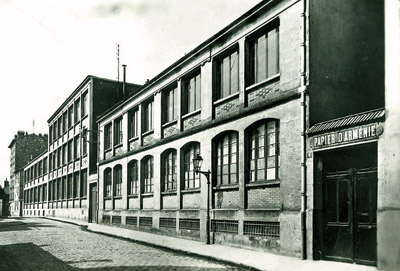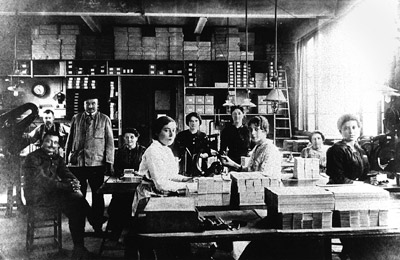
Papier d’Arménie - French Pharmacists Transform Traditional Armenian Disinfectant into Brand Name Room Freshener
Bird-like lettering in a group of articles on display for sale in a Parisian pharmacy caught my eye and I went to take a closer look. The item in question was named « Papier d’Arménie ». « What’s this? » I asked the druggist, who seemed pleased at my interest in the item. “There’s a country called Armenia. During the 19th century the plague had spread throughout the land and nothing seemed able to stop its deadly advance. They finally started to burn benzoin resin (a balsamic resin obtained from the bark of several species of trees in the genus Styrax).
They found that the smoke, by diffusing into the air, would cure the sickness. A Frenchman travelled to Armenia and brought back the secret. They have forgotten about all this in Armenia but it continues to be produced here in France.” Mireille Schvartz, head of the company Papier d’Arménie, Told me that in 19th century Armenian households people burned the resin to ward off air-borne viruses and as a simple room deodorizer.

At the end of the 19th century, French pharmacist Auguste Ponsot came upon the practice during the course of his travels and was amazing at the purifying effects it had. Ponsot brought his find back to France and with the help of a pharmacist colleague, Henri Rivier, the grandfather of Mireille Schvartz, they discovered that the resin could be dissolved in alcohol at a temperature of 90 C, and then infused onto a blotting paper support. And voila! Typically, a strip of is torn from the booklet, folded accordion-style, and placed on a heat-resistant support. The strip is lit and blown on until the paper begins to glow and release the vanilla scent characteristic of resin compounds.

Papier d'Arménie has been manufactured in France since 1885, first in Paris and then in Montrouge, a town neighboring the capital. Today, it enjoys the title of the oldest business still operating in Montrouge.

“My grandfather and Ponsot soon parted ways. Grandpa Rivier retained control of the business, passing it down to my father and later my mother. I’ve been heading the company since 1993. When I took over as president the company was on the edge of ruination. One day, we received an invitation to attend a biological exhibition. We went, displayed our wares, and got great rave reviews. The orders started to pour in. It saved our skin. Back in the day we were selling about 220,000 booklets a year. Today, that number is more like 2,000,000. Even back in my grandfather’s day the company exported to Canada. Today, the Japanese have shown great interest in the paper. It’s sold all across western Europe,” stated Mr. Schvartz.
Over the years, the manufacturing process was mechanized. Today, the company employs a total of nine workers. The Styrax trees from which the resin is obtained are imported from Laos. The entire process from resin to paper takes six months.

Mr. Schvartz noted that benzoin resin is widely used in the pharmaceutical profession and is particularly prescribed for lung and respiratory ailments. It is also used to treat and dry skin wounds. Back in 1889 at the first exhibition of Papier d’Arménie, the two pharmacists conducted an experiment. They placed a piece of raw meat in each of two plates and covered them with a cylinder. In the one plate they lit a piece of the magic paper. A week later they removed the cylinders. The untreated meat had gone bad while the meat treated with the paper was relatively unspoiled. This was their first public relations success and the product quickly took off, winning various medal and awards.
Papier d’Arménie, a family tradition in French households for decades, came out with new additions to its product line on the occasion of the celebration of Armenian Year in France when it teamed up with famous createur-parfumeur Francis Kurkdjian (Dior, Versace, Jean Paul Gaultier, Yves Saint Laurent, Giorgio Armani).
“Francis Kurkdjian called me up one day and told me ‘I’m Armenian and I really like your Papier d'Arménie and I’d like to do something for ArmeniaYear. And that’s how a new booklet was created. We got the inspiration for the cover from an old booklet in my grandfather’s collection. When Francis saw it he said it looked familiar. Later, he looked it up in an Armenian alphabet book and said that it was the letter “Բ” (Ben-2nd letter in the Armenian alphabet). With the help of a designer, we took the letter, bent it a bit, and came up with the letter “P”. We made up a bunch of the booklets and handed them out during the Armenia Year festivities and events here in France. Afterwards, we sold them and the demand continued. So we continued to manufacture the booklets. Then we introduced “La Bougie “(The candle). This year we’ve come out with a rose scented one. Sales are good but we have to take a small break,” stated the company president.
Papier d’Arménie’s product line is highly regarded in France today. Marketing research shows that one on every four French households uses one of the company’s products and that 71% recognize the brand name. President Schvartz lamented the fact that Armenia was clueless about the company and its link to the country’s past. He expressed the hope that after this article appears in the press, people in Armenia will want to try the product as well. Just imagine... Papier d'Arménie exported to Armenia.
“French-Armenians are very familiar with us. They’re always calling up and asking if I am Armenian. I answer no; I’m not Armenian, but that I’m Armenian in my heart.”
 Videos
Videos Photos
Photos




Write a comment